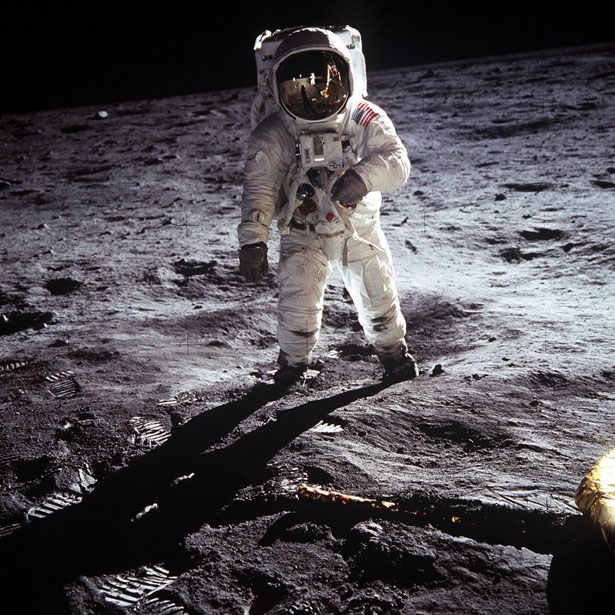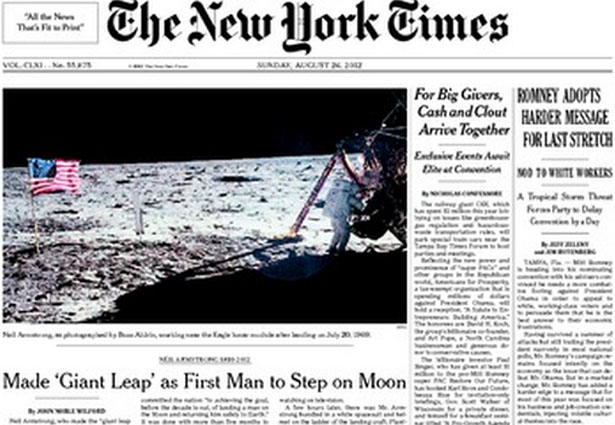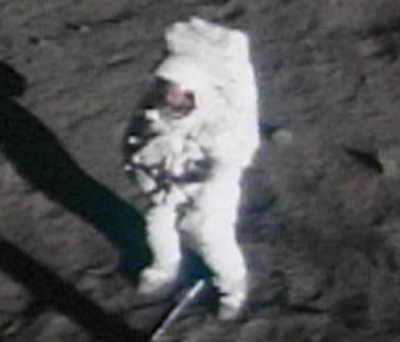The Missing Man: There Are No Good Pictures of Neil Armstrong on the Moon
The iconic images from the Apollo 11 lunar landing are all of Buzz Aldrin or his footprint.

If there is one thing everybody knows about Neil Armstrong, it is this: "One small step for [a] man, one giant leap for mankind." This quotation, in my mind at least, appears illustrated, conjuring the image above of an imprint left by a human boot upon the dusty lunar surface.
Except that's not the first step, nor was it left by Armstrong. It's a footprint made by Buzz Aldrin, the second man to walk on the moon.
Well that's okay, we'll just illustrate stories about Neil Armstrong's life with a picture of him on the moon. Here's one:

But the only place Armstrong appears in this picture is in the reflection on Buzz Aldrin's helmet. Zoom in a bit and you can make him out.
There are many, many pictures from the two-and-a-half hours Aldrin and Armstrong spent on the moon, but there are none -- zero -- of Armstrong posing for the camera. This is why, if you got the New York Times national print edition on Sunday, you saw this:

That's it, the best color picture we have of the first man on the moon while he was on the moon. Aldrin took a landscape shot of the site, inadvertently capturing Armstrong as he retrieved equipment from storage.
According to Charles Apple, a writer who covers journalistic visuals, this is the only picture we have of Neil Armstrong's face while he was outdoors on the moon, and it's a still taken from a timelapse movie of the lunar landing.
Other stills from film show Armstrong on the moon, such as this one that actually does capture that "small step for [a] man."

The explanation for this paucity is murky at best, prone to the uncharitable reading that Aldrin was getting "Armstrong back by taking no photographs of him on the Moon" in retribution for Armstrong getting the honor of first to set foot on the lunar surface.
But this is speculation at best. Aldrin, at least, has always said that the lapse was inadvertant, the result of Armstrong carrying the camera most of the time, a picture of Armstrong not appearing on the bucket list of things to do while on the moon, and Armstrong never stopping to ask for one. According to Aldrin, he was about to take a picture of Armstrong at the flag ceremony when President Nixon called, distracting them from the task.
This explanation doesn't quite check out. As James R. Hansen tells it in his book First Man: The Life of Neil A. Armstrong:
However, the sequence of events as evidenced in the NASA communications transcript shows that the first word of Nixon's call did not come to the astronauts until well after Neil took the picture of Aldrin saluting the flag; the picture was taken during a break in communications very shortly after 04:14:10:33 elapsed time whereas the news that Nixon wanted to talk to them came at 04:14:15:47. During most of that five-minute-and-fourteen-second interval, the two men were no longer even together. Following the flag planting, Armstrong moved back to the LM, the camera still with him. There, at the MESA, he prepared to collect his first rock samples. Aldrin moved out westward from the LM a distance of some fifty feet before rejoining Neil at the MESA.
Hansen continues:
In his autobiography, Aldrin excuses what he failed to do. "As the sequence of lunar operations evolved, Neil had the camera most of the time, and the majority of the pictures taken on the Moon that include an astronaut are of me [author's emphasis]. It wasn't until we were back on Earth and in the Lunar Receiving Laboratory looking over the pictures that we realized there were few pictures of Neil. My fault perhaps, but we had never simulated this during our training."
"We didn't spend any time worrying about who took what pictures," Armstrong graciously recalls. "It didn't occur to me that it made any difference, as long as they were good.
"I don't think Buzz had any reason to take my picture, and it never occurred to me that he should. I have always said that Buzz was the far more photogenic of the crew."
Later, Aldrin expressed regret about the oversight. "When I got back and someone said, 'There's not any of Neil,' I thought, 'What in the hell can I do now?' I felt so bad about that. And then to have somebody say that might have been intentional.... How do you come up with a nonconfrontational argument against that? I mean, that was just such a divisive observation, and Neil and I were never in the least divisive. We really were intimidated by the situation we found ourselves in on the Moon, hesitant and with an unclear idea of what to do next."
Hansen's book includes a handful of divergent opinions from different NASA administrators, theorizing as to how this, what Hansen calls "one of the minor tragedies of Apollo 11," could have happened. Was it mere oversight or petty payback? Men sticking close to the plan or men sticking too close to the plan?
In the end, who knows? And, even more to the point, who cares? The lack of a good Neil-Armstrong-on-the-Moon picture is sad, but speculation as to the reasons why obscures the greatness of the feat. What we know is what matters: They were there. Even without a picture, we can imagine Armstrong forever taking that step, forever bounding across the moon's surface. And for those of us who would like a visual, Neil Armstrong on the moon, there's this picture of him after the lunar walk, but very much on the moon's surface in the lunar module, with tears in his eyes.

